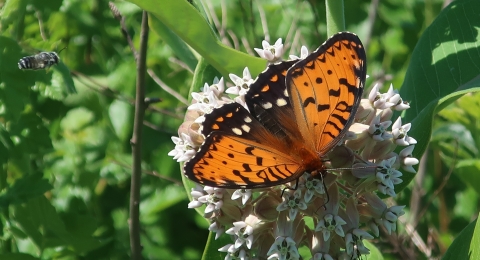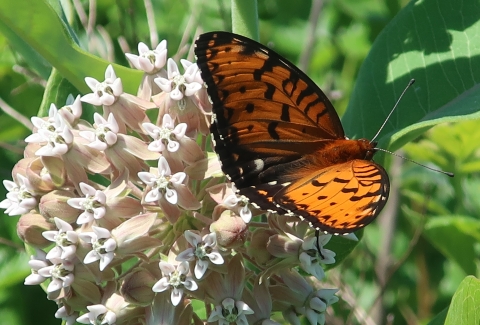DENVER — Today, the U.S. Fish and Wildlife Service announced a proposal to list both subspecies of the regal fritillary, a large butterfly, under the Endangered Species Act (ESA). Based on a review of the best available science, the Service is proposing to list the eastern regal fritillary (Argynnis idalia idalia) as endangered, and the western regal fritillary (Argynnis idalia occidentalis) as threatened with an accompanying 4(d) rule. The proposed rule is now available in the Reading Room for public inspection and will be posted in the Federal Register tomorrow, opening a 60-day public period through October 7, 2024. This recommendation is informed by an independently peer-reviewed Species Status Assessment.
This Species Status Assessment (SSA) report provides the best available biological information and commercial data to inform the Service’s decisions for the regal fritillary under the Endangered Species Act, including classification determinations for the subspecies and any other actions, as needed. The SSA will be updated as needed. This version incorporates the most recent data available. More information about SSAs can be found here.
Once found from New Brunswick to North Carolina, the eastern regal fritillary is now limited to a single location at the Fort Indiantown Gap National Guard installation in Annville, Pennsylvania. The western regal fritillary is found in 14 states in the native grasslands of the central and northern Great Plains and portions of the Midwest (Arkansas, Colorado, Iowa, Illinois, Indiana, Kansas, Minnesota, Missouri, North Dakota, Nebraska, Oklahoma, South Dakota, Wisconsin, and Wyoming). Both subspecies need violets to support larval growth, nectar sources that sustain breeding females into the fall, and native grasslands with tall vegetation that provide shelter for all life stages.
The eastern subspecies is in danger of extinction throughout its range. Because it is limited to a single location in the eastern U.S., where the National Guard has actively managed its only remaining grassland habitat, individual butterflies cannot disperse to other sites if this habitat is lost or degraded. The ongoing effects of climate change climate change
Climate change includes both global warming driven by human-induced emissions of greenhouse gases and the resulting large-scale shifts in weather patterns. Though there have been previous periods of climatic change, since the mid-20th century humans have had an unprecedented impact on Earth's climate system and caused change on a global scale.
Learn more about climate change and drought exacerbate threats to its rare habitat. Changes in temperature and moisture could impact bloom times and the overall productivity of native violet species, which the eastern regal fritillary’s caterpillars need to survive.
Despite the loss of grassland habitats across the rest of its native range, the eastern regal fritillary has persisted thanks to proactive efforts at Fort Indiantown Gap. The installation has successfully maintained the last population of the eastern regal fritillary in the world through land management and conservation, including prescribed burning, mowing, population surveys, and propagation.
In collaboration with the Service, Fort Indiantown Gap has developed a Candidate Conservation Agreement (CCA) to formalize its commitment to conserve the eastern regal fritillary. The agreement, finalized in February 2024, will be appended to the installation’s Integrated Natural Resources Management Plan, which identifies key natural resources and the actions needed to manage them.
In May 2024, the Service, Fort Indiantown Gap, and Temple University received more than $1 million from the Department of the Army to help implement the actions identified in the CCA, including managing habitat, developing a long-term monitoring protocol for the existing population, and establishing a new population in collaboration with the Pennsylvania Game Commission.
The status assessment found the western subspecies is not in immediate danger of extinction but is likely to be in danger of extinction in the foreseeable future due to these primary threats: habitat loss, grassland conversion resulting from agricultural and urban development, pesticide use, invasive plants, climate change, drought, local climate events, and collection to mention some.
In addition, the Service is proposing an accompanying 4(d) rule for the western subspecies under the ESA to allow for tailored landscape management actions to balance conservation and land management considerations. The proposed rule recognizes the vital role of grazing practices in maintaining grassland ecosystems. As a result, the proposed 4(d) for the western regal fritillary would exempt most activities associated with livestock grazing from incidental take, so ranchers would not need approval from the Service to continue those activities. For a complete list of those exemptions, please see the 4(d) rule.
How to submit comments
Comments on the proposal may be submitted during the 60-day public comment period, August 6 through October 7, 2024, through one of the following methods:
- Online at regulations.gov, Docket No, FWS-R6-ES-2023-0182
- By hard copy: Submit by U.S. mail to: Public Comments Processing, Attn: FWS-R6-ES-2023-0182, U.S. Fish and Wildlife Service, MS: PRB/3W, 5275 Leesburg Pike, Falls Church, VA 22041–3803.




